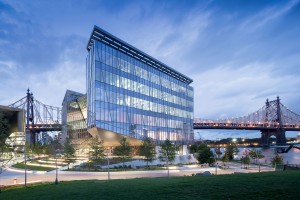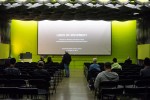The environments in which architects Marion Weiss and Michael Manfredi spent their childhoods shaped their future work: the hilly California topography that surrounded Weiss and the measured balance between architecture and open space that characterized Manfredi’s home in Rome.
“The places that we grew up were so tied inextricably to landforms and landscapes that we couldn’t imagine it being any other way,” Weiss said.
The founders of the design practice WEISS/MANFREDI gave a lecture Monday night as part of the UCLA Architecture and Urban Design 2018-2019 lecture series. Their presentation was selected as the Richard Weinstein Lecture, which is given once a year in honor of the former dean of UCLA’s Graduate School of Architecture and Urban Planning. In Perloff Hall, Weiss and Manfredi detailed several of the projects they worked on as well as their interest in fusing components of the local ecology, culture, infrastructure and architecture in each one. They also addressed the role of climate change and disaster management, particularly flooding, in their design process.
“Our realization is that these major problems can’t just be solved by architecture or landscape architecture or engineering, but really need to be solved comprehensively,” Manfredi said.
Growing up in Rome, Manfredi recalled playing in the Villa Lante al Gianicolo – a Renaissance villa that houses a garden – and being unable to judge whether the villa or the garden was more important. The experience left him with the realization that the inside and outside world were tightly and inseparably linked.
The balance between landscape and architecture characterized the pair’s work on the Brooklyn Botanic Garden Visitor Center, built in 2012. As Weiss explained during the lecture, they sought an equilibrium between the garden and the city; they produced, along with other elements, a green roof sustaining plants and wildlife.
Audience member Mengdi Zhang said he appreciated how the architects regarded the landscape as part of their projects, rather than relegating it to an outside consultant.
Weiss and Manfredi also take into consideration the effect of climate change on the locations they design. In trying to accept and leverage the forces of nature in their work, Manfredi compared the process to Japanese martial art aikido.
“The environmental concerns of today are so broadly impacting everything we do that, in fact, we have to think of the terrain that we’re engaging long before we actually think about what the form of architecture should be,” Weiss said.

Their design of Hunter’s Point South Waterfront Park in New York incorporated wetlands to capture, hold and release floodwater, Manfredi said. They also built a circular patch of grass that served as a cistern, which helped the park absorb the impact of 2012’s Hurricane Sandy.
“What we like to do is imagine that if we don’t think of things as climate tragedies but climate events, that those events might be things that we can submit to, and hence the Hunter’s Point South Park actually submits and invites the water in and then releases it, as opposed to a traditional force of a man-made wall to push against it,” Weiss said.
Weiss and Manfredi elaborated on some of the other features of the waterfront park, such as a canopy over a ferry stop that collects solar energy. They showed both the initial charcoal drawings and the video walk-throughs of their other completed projects as well, which include the Olympic Sculpture Park in Seattle, Tata Innovation Center at Cornell Tech and the U.S. Embassy in New Delhi. Their presentation ended with a Q&A session with the audience.
Another attendee, Phillip Harris, said he enjoyed seeing some of the early sketches of Weiss and Manfredi’s projects and how their designs mediate between the terrain and architecture.
“I appreciate how they’re one of the few firms today that are actually working with landscape equally as much as hardscape, as architecture,” he said. “And I think it’s kind of inspiring to see that they’re treating urban situations as an opportunity to give back some kind of softscape in an environment that we so characteristically see as being so rigid and so hard all the time.”
